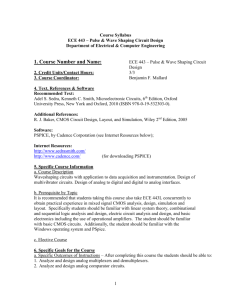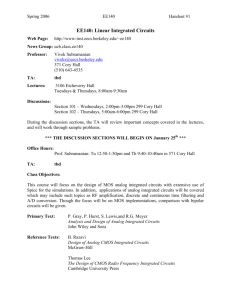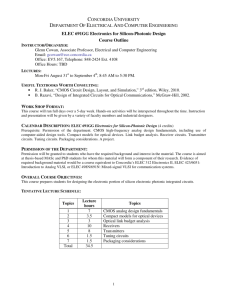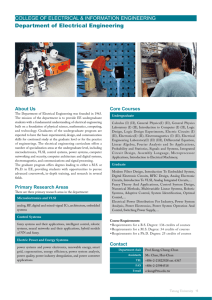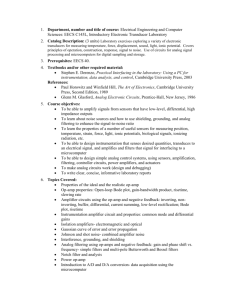EE 581 Analog and Mixed Signal Circuits
advertisement
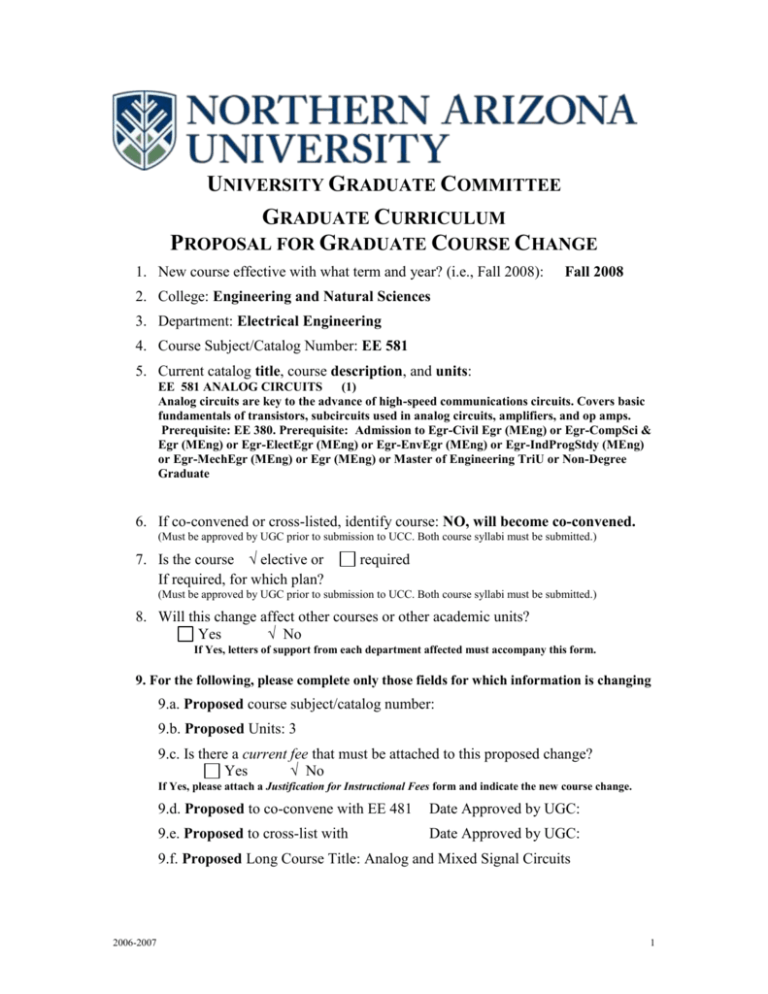
UNIVERSITY GRADUATE COMMITTEE GRADUATE CURRICULUM PROPOSAL FOR GRADUATE COURSE CHANGE 1. New course effective with what term and year? (i.e., Fall 2008): Fall 2008 2. College: Engineering and Natural Sciences 3. Department: Electrical Engineering 4. Course Subject/Catalog Number: EE 581 5. Current catalog title, course description, and units: EE 581 ANALOG CIRCUITS (1) Analog circuits are key to the advance of high-speed communications circuits. Covers basic fundamentals of transistors, subcircuits used in analog circuits, amplifiers, and op amps. Prerequisite: EE 380. Prerequisite: Admission to Egr-Civil Egr (MEng) or Egr-CompSci & Egr (MEng) or Egr-ElectEgr (MEng) or Egr-EnvEgr (MEng) or Egr-IndProgStdy (MEng) or Egr-MechEgr (MEng) or Egr (MEng) or Master of Engineering TriU or Non-Degree Graduate 6. If co-convened or cross-listed, identify course: NO, will become co-convened. (Must be approved by UGC prior to submission to UCC. Both course syllabi must be submitted.) 7. Is the course √ elective or If required, for which plan? required (Must be approved by UGC prior to submission to UCC. Both course syllabi must be submitted.) 8. Will this change affect other courses or other academic units? Yes √ No If Yes, letters of support from each department affected must accompany this form. 9. For the following, please complete only those fields for which information is changing 9.a. Proposed course subject/catalog number: 9.b. Proposed Units: 3 9.c. Is there a current fee that must be attached to this proposed change? Yes √ No If Yes, please attach a Justification for Instructional Fees form and indicate the new course change. 9.d. Proposed to co-convene with EE 481 Date Approved by UGC: 9.e. Proposed to cross-list with Date Approved by UGC: 9.f. Proposed Long Course Title: Analog and Mixed Signal Circuits 2006-2007 1 9.g. Proposed Short Course Title (30-character/space maximum): Analog/Mixed Signal Circuits 9.h. Proposed Catalog Course Description (60-word maximum): Analysis and design of op-amps, comparators, sample and hold circuits, switched capacitor circuits, dynamic analog circuits and data converters. Introduction to low-voltage, low-power design techniques for mixed-signal CMOS ICs. The physical design issues and layout techniques will also be addressed. 9.i. Proposed Grading Option: √ Letter Grade Pass/Fail Both (If both, the course may be offered one way for each respective section.) 9.j. May proposed course change be repeated for additional units? Yes √ No If Yes, maximum units that may be repeated: 9.k. Please check ONE of the following that most accurately describes the format of the course: √ Lecture Only Seminar Lab Only Field Studies Lecture and Lab Combined Independent Study Clinical Activity Research Supervision 9.l. If the course will be delivered electronically, check ONE of the following: Web ITV Other (hybrid, for example). Please explain: 10. Prerequisites: (must be completed before taking proposed course): EE 380 11. Corequisites: (must be completed with proposed course): N/A 12. If course has no requisites, what consent will be required for all sections? (Check only one.) Instructor Consent Department Consent No Consent Required. 13. Justification for course change: Changing the credit hours to 3, so it can be offered as a regular/full course for grad student. This course will also strengthen the Master of Science in Engineering with an emphasis in Electrical Engineering. Course description has been revised to describe the course content in more detail. The new course content will also prepare students to have better background for careers in Analog and mixed signal circuit design field. 2006-2007 2 14. Approvals _____________________________________________________________________ Department Chair (if appropriate) Date _____________________________________________________________________ Chair of college curriculum committee Date _____________________________________________________________________ Dean of College Date For University Graduate Committee use only Approved: ___________________________________________________________ Date 2006-2007 3 EE 581 Course Syllabus Analog and Mixed Signal Circuits Semester: Spring 2009 Credit hours: 3.0 (lecture) Course web page: Blackboard VISTA Class times: Lecture TTh 11:10 – 12:25 pm room 106, Engineering Instructor: Dr. Nazmul Islam Office: Room 322E, Engineering Phone: (928) 523-5262 E-mail: Nazmul.Islam@nau.edu Office hours: T TH 1:00pm – 3:00pm, and by appointments COURSE PREREQUISITE: EE 380 COURSE DESCRIPTION: Analysis and design of op-amps, comparators, sample and hold circuits, switched capacitor circuits, dynamic analog circuits and data converters. Introduction to low-voltage, low-power design techniques for mixed-signal CMOS ICs. The physical design issues and layout techniques will also be addressed. LEARNING OUTCOME OF THIS COURSE The student is able to: 1. Analyze and design op-amps, comparators, sample and hold circuits, switched capacitor circuits, non-linear analog circuits and data converters. 2. Design multi-stage MOS amplifier circuits to meet given specifications such as gain, frequency, power, and area specifications. 3. Use low-voltage, low-power design techniques for mixed-signal CMOS ICs. 4. Use electronic computer-aided design software (Mentor Graphics) to simulate and characterize circuits. The analog layout techniques will also be addressed. REQUIRED TEXT R. Jacob Baker, CMOS, Circuit Design, Layout and Simulation, Wiley-Interscience, 2008 (2nd Edition -- Revised). ISBN: 978-0-470-22941-5 REFERENCE TEXTS 1. P. Gray, P. Hurst, S. Lewis, R. Meyer, "Analysis & Design of Analog Integrated Circuits," 4th Edition,WILEY, 2001. 2. P. Allen, D. Holberg, "CMOS Analog Circuit Design, Second Edition," Oxford, 2002. 3. D. Johns, K. Martin, "Analog Integrated Circuit Design," Wiley, 1997. 4. B. Razavi, “Design of Analog CMOS Integrated Circuits,” McGraw Hill, 2001 Additional research papers and journal articles will be provided by instructor. COURSE GRADING The course grade will be based upon mid-term exam, projects, homework, quizzes, and final exam. Grades will also be based on presenting your work in a well organized, neat, clear, and professional manner using standard technical terms and symbols. Course grading criteria: Homework 10 % Quizzes 10% 2006-2007 4 Mid-term Final Exam Projects 15 % 20 % 45 % -------- Total 100 % Final grades will be determined by the following percentages: A = 90+, B = 80-89, C = 70-79, D = 60-69, F = below 60 Graduate student will have 3 additional assignment and different set of exam questions. Graduate students need to give presentation on their projects. GRADUATE STUDENTS COURSE LOAD Both undergraduate and graduate students are expected to do homework and project components of this course. However, each homework assignment will have an extra problem included specifically for the graduate students; undergraduates are not required to do this extra problem. Similarly, each project will have a section designated for graduate students only. Undergraduates are not required to do this extra section of each mini-project. Graduate students have an additional project, not required of the undergraduate students. If desired, however, undergraduates may work any of the extra graduate homework problems or extra mini-project sections for extra credit. The graduate students of this course will help the instructor to put the layouts of the design on the pad-frame, so it can be sent to MOSIS for fabrication. After getting the IC (integrated circuit) back from fabrication, thorough testing will also be done to check the functionality of the design. These extra activities comprise the 30% additional workload for the graduate students compared to the undergraduate students. PROJECTS The projects will consist primarily of hand analysis along with schematic capture, simulation and layout using Mentor Graphics computer-aided design software. A project report will be required. There will be 4 project assignments for graduate students, covering the following topics: Project 1. Designing of a CMOS low power bandgap voltage reference Project 2. Source cross-coupled differential amplifier Project 3. Two stage CMOS operational amplifier design Project 4. Designing Pipeline digital to analog converter (DAC) EXAMS The exams will have a mixture of questions. There will be some questions to test fundamental knowledge, questions to test conceptual understanding, and questions to solve circuit problems. The exams will cover the chapters since the previous exam but you will be expected to be able to utilize concepts from all previous chapters. You will be allowed one 8.5” x 11” sheet of notes so you will not need to memorize material but be able to apply it easily. The final exam will be comprehensive - an excellent opportunity to review material from the semester. The exam questions for the graduate student will be different than that of under-graduate student. QUIZZES During at least 6 regular class periods throughout the semester, a short quiz will be given. These quizzes are worth 10 points each, but only your 5 highest quiz scores will count toward your final grade. The remainder will be dropped. Quizzes will not be announced in advance. Also, they may occur anytime during the class period: beginning, middle, or end. If you are not present 2006-2007 5 when a quiz is given, you will receive a zero for that quiz. No make-up quizzes will be allowed under any circumstances. Suggested strategy: keep current, attend class, and be ready. ATTENDANCE & CLASS PARTICIPATION Students are expected to be on time and to attend every class. I appreciate your attentiveness and participation during class. Please feel free to ask questions about course material, homework and lab assignments, textbook, or any other topic. No laptops. Please, no eating during class and turn off cell phones. It’s OK to have something to drink. I will expect mandatory attendance for the graduate student and will seek feedback on improving this course. ACADEMIC INTEGRITY Cheating - claiming another student's work as your own or permitting another student to claim your work. Plagiarism - claiming another person's writing as your own. I encourage you to discuss homework problems, solution methods and answers with other students but you cannot simply copy another student's paper and hand it in. Working together is OK and encouraged. Copying, however, is cheating and both the student who copies and the student who provides the solution will be punished. Cheating and plagiarism will not be tolerated at this university. Violators will be penalized in accordance with the Academic Integrity policy. If you have any questions, ask. POLICY STATEMENTS These NAU policies will be followed in this class. You may obtain a copy of these policies from http://jan.ucc.nau.edu/academicadmin/policy1.html SAFE ENVIRONMENTAL POLICY ACADEMIC INTEGRITY ACADEMIC CONTACT HOUR POLICY CLASSROOM MANAGEMENT STATEMENT Membership in the academic community places a special obligation on all members to preserve an atmosphere conducive to a safe and positive learning environment. Part of that obligation implies the responsibility of each member of the NAU community to maintain an environment in which the behavior of any individual is not disruptive. PROFESSIONAL ETHICS AND CODE OF CONDUCT Exceptionally high standards of honor and integrity are fundamental and essential to the study and practice of engineering. Academic preparation for the profession must be conducted in an atmosphere which fosters these values. LECTURE OUTLINE Although the lectures will generally follow the material in the text, I will occasionally skip certain material. The proposed schedule and sequence below may change somewhat. Week Text Reference 1. Course overview, Review Chapters 1 - 6 2. CMOS passive elements, noise characteristics Chapter 7 3. Analog MOSFET models Chapter 9 4. Current sinks and sources Chapter 20 2006-2007 6 5. Reference circuits, common source (CS) amplifiers Chapter 21 6. Cascode amplifiers Chapter 21 7. Feedback & differential amplifiers Chapter 22 8. Differential amplifiers Chapters 22 & 23 9. Operational amplifiers & Mid-term Exam Chapters 24 10. Spring Break 11. Op Amps Chapter 24 12. Op Amps (continued) Chapter 24 13. Switched capacitor & sample and hold circuits Chapter 25 14. Non-linear analog circuit (e.g.,comparators) Chapter 27 15. Data converter (DAC & ADC) Chapter 28 16. Data converter architecture Chapter 29 17. Final Exam 2006-2007 7 Course Syllabus EE 481 Analog and Mixed Signal Circuits Chapter 2 Chapter 3 Semester: Spring XX Chapter 4 Credit hours: 3.0 (lecture) Chapter 5 Course web page: Blackboard VISTA Chapter 6 Class times: Lecture TTh 11:10 – 12:25 pm room 106, Engineering Chapter 7 Instructor: Dr. Nazmul Islam Chapter 8 Chapter 9 Office hours: T Th 1:00 – 3:00 pm COURSE PREREQUISITE: EE 380 COURSE DESCRIPTION: Analysis and design of op-amps, comparators, sample and hold circuits, switched capacitor circuits, dynamic analog circuits and data converters. Introduction to low-voltage, low-power design techniques for mixed-signal CMOS ICs. LEARNING OUTCOME OF THIS COURSE The student is able to: 5. Analyze and design op-amps, comparators, sample and hold circuits, switched capacitor circuits, non-linear analog circuits and data converters. 6. Use low-voltage, low-power design techniques for mixed-signal CMOS ICs. 7. Use electronic computer-aided design software (Mentor Graphics) to simulate and characterize circuits. REQUIRED TEXT R. Jacob Baker, CMOS, Circuit Design, Layout and Simulation, Wiley-Interscience, 2008 (2nd Edition -- Revised). ISBN: 978-0-470-22941-5 REFERENCE TEXTS 5. P. Gray, P. Hurst, S. Lewis, R. Meyer, "Analysis & Design of Analog Integrated Circuits," 4th Edition,WILEY, 2001. 6. P. Allen, D. Holberg, "CMOS Analog Circuit Design, Second Edition," Oxford, 2002. 7. D. Johns, K. Martin, "Analog Integrated Circuit Design," Wiley, 1997. 8. B. Razavi, “Design of Analog CMOS Integrated Circuits,” McGraw Hill, 2001 Additional research papers and journal articles will be provided by instructor. COURSE GRADING The course grade will be based upon mid-term exam, projects, homework, quizzes, and final exam. Grades will also be based on presenting your work in a well organized, neat, clear, and professional manner using standard technical terms and symbols. Course grading criteria: Homework Quizzes Mid-term Final Exam Projects 10 % 10% 15 % 20 % 45 % -------- Total 2006-2007 100 % 8 Final grades will be determined by the following percentages: A = 90+, B = 80-89, C = 70-79, D = 60-69, F = below 60 At the professor’s discretion, grading thresholds may be relaxed slightly. PROJECTS The project will consist primarily of hand analysis along with schematic capture, simulation and layout using Mentor Graphics computer-aided design software. A project report will be required. There will be 3 project assignments covering the following topics: Project 1. Designing of a CMOS low power bandgap voltage reference Project 2. Source cross-coupled differential amplifier Project 3. Two stage CMOS operational amplifier design EXAMS The exams will have a mixture of questions. There will be some questions to test fundamental knowledge, questions to test conceptual understanding, and questions to solve circuit problems. The exams will cover the chapters since the previous exam but you will be expected to be able to utilize concepts from all previous chapters. You will be allowed one 8.5” x 11” sheet of notes so you will not need to memorize material but be able to apply it easily. The final exam will be comprehensive - an excellent opportunity to review material from the semester. QUIZZES During at least 6 regular class periods throughout the semester, a short quiz will be given. These quizzes are worth 10 points each, but only your 5 highest quiz scores will count toward your final grade. The remainder will be dropped. Quizzes will not be announced in advance. Also, they may occur anytime during the class period: beginning, middle, or end. If you are not present when a quiz is given, you will receive a zero for that quiz. No make-up quizzes will be allowed under any circumstances. Suggested strategy: keep current, attend class, and be ready. ACCREDITATION BOARD FOR ENGINEERING AND TECHNOLOGY ABET Professional Requirements contribution of this course: 2 credits of engineering science, 1 credit design. This course is designed to meet the following ABET learning objectives and outcomes. The numerical rating indicates the level of emphasis. A (1) is exposure and a (5) is mastery. Outcomes listed (N/A) are not addressed by this course. Objective 1 – Students receive a personalized college experience in which high quality teaching, advising and mentoring are emphasized. (4) Outcome 1.1 Be a leader in educational innovation and the use of technology in providing a quality educational experience in the classroom and in distance settings. (3) Outcome 1.2 Attract and retain well-qualified students. (2) Outcome 1.3 Foster advising and mentoring relationships between faculty and students. Objective 2 – Graduates are technically competent and prepared for leadership and professional practice with strength in design, problem solving, communications and teaming. (2) Outcome 2.1 Possess professional skills and knowledge of the design process. (2) Outcome 2.2 Ability to function in disciplinary and multi-disciplinary teams. (2) Outcome 2.3 Possess oral and written abilities to effectively communicate. (4) Outcome 2.4 Abilities in creativity, critical thinking and problem identification, formulation and solving. 2006-2007 9 Chapter 10 Chapter 11 Objective 3 – Graduates are grounded in mathematics and engineering science fundamentals and prepared for advanced education and lifelong learning. (3) Outcome 3.1 Ability to apply knowledge of physics and mathematics (including calculus, linear algebra, complex variables and differential equations). (1) Outcome 3.2 Ability to apply knowledge of probability, statistics, Laplace transforms and Fourier transforms. (3) Outcome 3.3 Ability to design and conduct scientific and engineering experiments. (3) Outcome 3.4 Motivation and skills needed for lifelong learning. (5) Outcome 3.5 Ability to use industry standard analysis and design tools. Objective 4 – Graduates are experienced with and understand diverse populations, such as that existing in the American Southwest. (N/A) Outcome 4.1 Ability to relate a broad education and contemporary issues to engineering solutions and their impact in a societal and global context. (2) Outcome 4.2 An appreciation and understanding of professional and ethical responsibility. (3) Outcome 4.3 Attract and retain under-represented students. ATTENDANCE & CLASS PARTICIPATION Students are expected to be on time and to attend every class. I appreciate your attentiveness and participation during class. Please feel free to ask questions about course material, homework and lab assignments, textbook, or any other topic. No laptops. Please, no eating during class and turn off cell phones. It’s OK to have something to drink. ACADEMIC INTEGRITY Cheating - claiming another student's work as your own or permitting another student to claim your work. Plagiarism - claiming another person's writing as your own. I encourage you to discuss homework problems, solution methods and answers with other students but you cannot simply copy another student's paper and hand it in. Working together is OK and encouraged. Copying, however, is cheating and both the student who copies and the student who provides the solution will be punished. Cheating and plagiarism will not be tolerated at this university. Violators will be penalized in accordance with the Academic Integrity policy. If you have any questions, ask. POLICY STATEMENTS These NAU policies will be followed in this class. You may obtain a copy of these policies from http://jan.ucc.nau.edu/academicadmin/policy1.html SAFE ENVIRONMENTAL POLICY ACADEMIC INTEGRITY ACADEMIC CONTACT HOUR POLICY CLASSROOM MANAGEMENT STATEMENT Membership in the academic community places a special obligation on all members to preserve an atmosphere conducive to a safe and positive learning environment. Part of that obligation implies the responsibility of each member of the NAU community to maintain an environment in which the behavior of any individual is not disruptive. PROFESSIONAL ETHICS AND CODE OF CONDUCT 2006-2007 10 Exceptionally high standards of honor and integrity are fundamental and essential to the study and practice of engineering. Academic preparation for the profession must be conducted in an atmosphere which fosters these values. LECTURE OUTLINE Although the lectures will generally follow the material in the text, I will occasionally skip certain material. The proposed schedule and sequence below may change somewhat. Chapter 12 Week Text Reference 18. Course overview, Review Chapters 1 - 6 19. CMOS passive elements, noise characteristics Chapter 7 20. Analog MOSFET models Chapter 9 21. Current sinks and sources Chapter 20 22. Reference circuits, common source (CS) amplifiers Chapter 21 23. Cascode amplifiers Chapter 21 24. Feedback & differential amplifiers Chapter 22 25. Differential amplifiers Chapters 22 & 23 26. Operational amplifiers & Mid-term Exam Chapters 24 27. Spring Break 28. Op Amps Chapter 24 29. Op Amps (continued) Chapter 24 30. Switched capacitor & sample and hold circuits Chapter 25 31. Non-linear analog circuit (e.g.,comparators) Chapter 27 32. Data converter (DAC & ADC) Chapter 28 33. Data converter architecture Chapter 29 34. Final Exam 2006-2007 11 2006-2007 12

